-
 Thin iron tsuba of round form with design of family crests (mon) and arabesque (karakusa) in brass or copper inlay (suemon-zōgan) and occasional scattered brass dots or nail heads in ten-zōgan. Seppa-dai outlined with brass wire in the shape of a rope; kozuka-hitsu-ana outlined with scalloped brass wire. Rounded rim with iron bones (tekkotsu). The surface covered with lacquer (urushi). Ōnin school. Late Muromachi period, 16th century. Family crests on the face: 1:30: Two lines (double stripe) encircled (maruni futatsu biki). 4:30: Stylized clove (choji). 7:30: Divided rhombus, or four lozenges incorporated in one (wari-bishi); it is also called Takeda-bishi, the family crest of warrior Takeda Shingen (among the others). 10:00: Stylized Genji-mon (Genji kō-zu) or incense symbol. On the reverse: 2:00 - "Chinese cloud" not a crest. 5:00: Bit (Kutsuwa) 7:30: Number four in a fan (ōgi-san) 10:30: Two dots in a well frame (igeta).
Thin iron tsuba of round form with design of family crests (mon) and arabesque (karakusa) in brass or copper inlay (suemon-zōgan) and occasional scattered brass dots or nail heads in ten-zōgan. Seppa-dai outlined with brass wire in the shape of a rope; kozuka-hitsu-ana outlined with scalloped brass wire. Rounded rim with iron bones (tekkotsu). The surface covered with lacquer (urushi). Ōnin school. Late Muromachi period, 16th century. Family crests on the face: 1:30: Two lines (double stripe) encircled (maruni futatsu biki). 4:30: Stylized clove (choji). 7:30: Divided rhombus, or four lozenges incorporated in one (wari-bishi); it is also called Takeda-bishi, the family crest of warrior Takeda Shingen (among the others). 10:00: Stylized Genji-mon (Genji kō-zu) or incense symbol. On the reverse: 2:00 - "Chinese cloud" not a crest. 5:00: Bit (Kutsuwa) 7:30: Number four in a fan (ōgi-san) 10:30: Two dots in a well frame (igeta). -
 Iron tsuba of round form, slightly convex, decorated with persimmon (kaki), simplified Genji-kō (incense game symbol) and halves of plum blossoms (ume) in brass inlay on both sides, and with part of bellflower (kikyo) in openwork. Outer rim, seppa-dai, bellflower openwork, and kozuka-ana outlined with brass inlay; traces of lacquer to surface. The symbolic meaning alludes to Chapter 20: Asagao (朝顔, the bellflower or "morning face") of Tale of Genji by Murasaki Shikibu (11th century AD). The events take place in the 9th lunar month (Nagatsuki) and involve the following poetry by Prince Genji: saku hana ni / utsuru chō na wa / tsutsumedomo / orade sugiuki / kesa no asagao [I would not have it said / that my heart has turned toward / a flower in bloom — / yet how hard it is to pass / without plucking a “morning face”!]. Measurements: H: 76.6 mm; W: 76.3 mm; Th.: 3.6 mm (seppa-dai), 3.0 mm (rim) Time: Late Muromachi (1514 – 1573).
Iron tsuba of round form, slightly convex, decorated with persimmon (kaki), simplified Genji-kō (incense game symbol) and halves of plum blossoms (ume) in brass inlay on both sides, and with part of bellflower (kikyo) in openwork. Outer rim, seppa-dai, bellflower openwork, and kozuka-ana outlined with brass inlay; traces of lacquer to surface. The symbolic meaning alludes to Chapter 20: Asagao (朝顔, the bellflower or "morning face") of Tale of Genji by Murasaki Shikibu (11th century AD). The events take place in the 9th lunar month (Nagatsuki) and involve the following poetry by Prince Genji: saku hana ni / utsuru chō na wa / tsutsumedomo / orade sugiuki / kesa no asagao [I would not have it said / that my heart has turned toward / a flower in bloom — / yet how hard it is to pass / without plucking a “morning face”!]. Measurements: H: 76.6 mm; W: 76.3 mm; Th.: 3.6 mm (seppa-dai), 3.0 mm (rim) Time: Late Muromachi (1514 – 1573). -
 Iron tsuba of quatrefoil form (mokka-gata) adorned with the design of stars, wild geese, blossoms, leaves and tendrils realized in the brass inlay. The inlay technique includes suemon-zōgan and ten-zōgan. A smaller opening (kozuka hitsu-ana) surrounded by a scalloped brass border. The seppa-dai bordered with linear inlay. A few dots of inlay on both sides are missing. Measurements: height 71 mm, width 70 mm, thickness at centre 2.7 cm Time: Late Muromachi (1514 – 1573)
Iron tsuba of quatrefoil form (mokka-gata) adorned with the design of stars, wild geese, blossoms, leaves and tendrils realized in the brass inlay. The inlay technique includes suemon-zōgan and ten-zōgan. A smaller opening (kozuka hitsu-ana) surrounded by a scalloped brass border. The seppa-dai bordered with linear inlay. A few dots of inlay on both sides are missing. Measurements: height 71 mm, width 70 mm, thickness at centre 2.7 cm Time: Late Muromachi (1514 – 1573) -
 Iron tsuba of slightly elongated round form (nagamaru-gata) pierced on top and in the bottom (ko-sukashi) with simplified Genji-kō (incense game symbol) and two petals of bellflower; openings, seppa-dai, and plate along the rim are outlined with brass wire, kozuka-ana outlined with scalloped brass wire, missing on the front; kogai-ana pierced later. The plate is slightly concave with traces of lacquer, decorated in brass (suemon-zōgan) with tendrils, bellflowers, and Genji characters, and with brass dots (ten-zogan), many of which are missing. Measurements: Height 77.5 mm; Width 75.5 mm; thickness at seppa-dai 2.4 mm, at rim 3.2 mm. Time: Late Muromachi (1514 – 1573) or earlier.
Iron tsuba of slightly elongated round form (nagamaru-gata) pierced on top and in the bottom (ko-sukashi) with simplified Genji-kō (incense game symbol) and two petals of bellflower; openings, seppa-dai, and plate along the rim are outlined with brass wire, kozuka-ana outlined with scalloped brass wire, missing on the front; kogai-ana pierced later. The plate is slightly concave with traces of lacquer, decorated in brass (suemon-zōgan) with tendrils, bellflowers, and Genji characters, and with brass dots (ten-zogan), many of which are missing. Measurements: Height 77.5 mm; Width 75.5 mm; thickness at seppa-dai 2.4 mm, at rim 3.2 mm. Time: Late Muromachi (1514 – 1573) or earlier. -
 Iron tsuba of a round form (maru-gata) pierced (sukashi) with two six-petal flowers at 6 and 12 o’clock and modified lozenges at 3 and 9 o’clock, and inlaid in brass (suemon-zōgan) with tendrils and flowers (chrysanthemum, cherry blossom, Chinese bellflower, paulownia); openings outlined with scalloped brass wire. The plate is slightly concave with traces of lacquer on the surface. Nakago-ana plugged with copper sekigane. Some elements of inlay missing. The rim with conspicuous tekkotsu, quite worn. Measurements: Height 92.0 mm; Width 86.3 mm; thickness at seppa-dai 3.2 mm, at rim 4.2 mm. Time: Late Muromachi (1514 – 1573) or earlier.
Iron tsuba of a round form (maru-gata) pierced (sukashi) with two six-petal flowers at 6 and 12 o’clock and modified lozenges at 3 and 9 o’clock, and inlaid in brass (suemon-zōgan) with tendrils and flowers (chrysanthemum, cherry blossom, Chinese bellflower, paulownia); openings outlined with scalloped brass wire. The plate is slightly concave with traces of lacquer on the surface. Nakago-ana plugged with copper sekigane. Some elements of inlay missing. The rim with conspicuous tekkotsu, quite worn. Measurements: Height 92.0 mm; Width 86.3 mm; thickness at seppa-dai 3.2 mm, at rim 4.2 mm. Time: Late Muromachi (1514 – 1573) or earlier. -
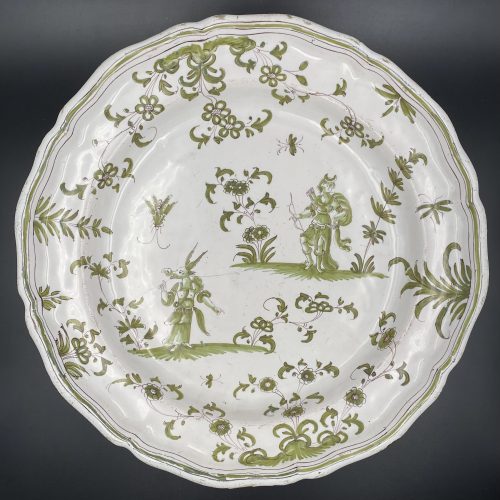 Moustiers faience plate: tin-glazed earthenware plate with a scalloped rim, with green monochrome grotesque decoration of a whimsical creature and a female archer, surrounded by flowering vegetation and insects. Marked "X" on the bottom. "Joseph Fouque/Jean-Francois Pelloquin, started in 1749, used an"X" in its pottery mark". Diameter: 31 cm; Height: 4 cm.
Moustiers faience plate: tin-glazed earthenware plate with a scalloped rim, with green monochrome grotesque decoration of a whimsical creature and a female archer, surrounded by flowering vegetation and insects. Marked "X" on the bottom. "Joseph Fouque/Jean-Francois Pelloquin, started in 1749, used an"X" in its pottery mark". Diameter: 31 cm; Height: 4 cm. -
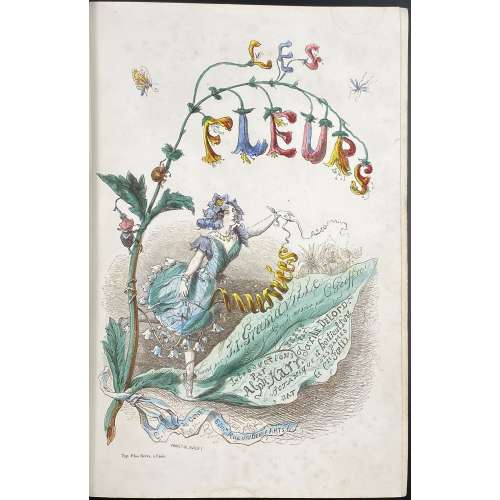 Description: Two parts in one volume, collated 4to, 26.3 x 18 cm, bound in quarter green pebbled morocco over green percaline panelled boards, spine with raised bands, gilt in compartments, lettered in gilt, signed in the bottom “L. Curmer”; marbled endpapers, all edges gilt. Part 1 is illustrated with a hand-coloured wood-engraved title-page by Porret and Blanadet and 28 hand-coloured steel engravings by Charles Geoffroy after J.-J. Grandville; part 2 is illustrated with a hand-coloured wood-engraved title-page by Quichon and 22 steel engravings by Charles Geoffroy after J.-J. Grandville, and two uncoloured botanical plates, unsigned. Title-page: LES | FLEURS ANIMÉES | PAR | J.-J. GRANDVILLE | INTRODUCTIONS | Par ALPH. KARR | TEXTE | Par TAXILE DELORD | — | PREMIÈRE (DEUXIÈME) PARTIE | — | PARIS | GABRIEL DE GONET, ÉDITEUR | 6, RUE DES BEAUX-ARTS, 6 || Collation: part 1: blank, [1] h.t./imprint (PARIS WALDER), hand-coloured engraved t.p., [1] t.p./blank, 1-324, [1] contents/blank, 28 hand-coloured plates; part 2: [1] h.t./imprint (PARIS WALDER), hand-coloured engraved t.p., [1] t.p./blank, [2] intro., [1]-294, 302, blank, 22 hand-coloured plates and 2 uncoloured plates. Pagination: part 1: [1-5] 6-260 [2] (total 262 pages), ils; part 2: [4] [i] ii-iv [1] 2-102, [2] [i] ii-iv, [105] 106-234 [2] (total 248 pages), ils. Coloured steel-engraved plates: Part 1: Bleuet et Coquelicot. Lis. Pensée. Tabac. Tulipe. Rose. Narcisse. Violette. Nenuphar. Laurier. Myrte. Marguerite. Camelia. Immortelle. Chèvre-feuille. Belle-de-nuit. Oeillet. Ciguë. Soleil. Fleur de grenadier. Lin. Eglantine. Pavot. Chardon. Fleur d'oranger. Capucine. Guimauve. Primevère – Perce-neige. Part 2: Pois de senteur. Cactus. Dahlia. Sensitive. Fleur de pêcher. Aubépine. Vigne. Myosotis. Jasmin. Scabieuse & Souci. Traite des fleurs. Flèche-d'eau. Hortensia, couronne impériale. Verveine. Giroflée. Thé et Café. Lilas. Tubéreuse Jonquille. Bal. Retour des fleurs. Erratum. Pervenche desséchée. Plates signed "Grandville del. – Ch. Geoffroy sc. – G. de Gonet, editeur" but some signed "Imp. Delamain et Sarazin rue Git le Cœur 8 Paris." Plates accompanied by tissue guards. Gordon N. Ray: "Most of the plates show an elegant lady in a garden, her dress covered with an extraordinary pattern of flowers. She is sometimes accompanied by respectful creatures, animals and insects, even fish and reptiles". Edition: 2nd edition of 1847, each part has separate pagination; imprint: "Paris. — Typographie Walder, rue Bonaparte, 44". Second "tirage", the volumes being paged separately; the first "tirage", issued also in 1847, is paged continuously. Point of issue: Table des Matières has "Imprimerte Walder." Originally appeared in 83 separate parts in pictorial yellow wrappers. Contributors: J.-J. Grandville [Gèrard, Isidore-Adolphe] (French, 1803 – 1847) – artist. Taxile Delord (French, 1815 – 1877) – author. Comte Foelix [Louis-François Raban] (French, 1795 – 1870) – author. Jean-Baptiste Alphonse Karr (French, 1808 – 1890) – author. Charles Michel Geoffroy (French, 1819 – 1882) – engraver (on steel). Gabriel de Gonet (French, fl. 1847 – 1862) – publisher. Typographie Walder (Paris) – printer. Plon Freres (Paris) – printer. Delamain et Sarrazin (Paris) – printer. Henri Désiré Porret (French, 1800 – 1867) – engraver (on wood). Jules Blanadet (French, 1824 – ?) – engraver (on wood). Quichon (French, fl. c. 1850s) – engraver (on wood). Catalogue raisonné: L. Carteret (Le trésor): p. 286; Ray (French): 198, pp. 278-9; Vicaire (Manuel): D III, p. 133-4; Brivois (Guide): pp. 147-150. In collections: MET 1970.565.423.1–.2; Vanderbilt University; V&A L.755-1943. Provenance: Léon Curmer (French, ).
Description: Two parts in one volume, collated 4to, 26.3 x 18 cm, bound in quarter green pebbled morocco over green percaline panelled boards, spine with raised bands, gilt in compartments, lettered in gilt, signed in the bottom “L. Curmer”; marbled endpapers, all edges gilt. Part 1 is illustrated with a hand-coloured wood-engraved title-page by Porret and Blanadet and 28 hand-coloured steel engravings by Charles Geoffroy after J.-J. Grandville; part 2 is illustrated with a hand-coloured wood-engraved title-page by Quichon and 22 steel engravings by Charles Geoffroy after J.-J. Grandville, and two uncoloured botanical plates, unsigned. Title-page: LES | FLEURS ANIMÉES | PAR | J.-J. GRANDVILLE | INTRODUCTIONS | Par ALPH. KARR | TEXTE | Par TAXILE DELORD | — | PREMIÈRE (DEUXIÈME) PARTIE | — | PARIS | GABRIEL DE GONET, ÉDITEUR | 6, RUE DES BEAUX-ARTS, 6 || Collation: part 1: blank, [1] h.t./imprint (PARIS WALDER), hand-coloured engraved t.p., [1] t.p./blank, 1-324, [1] contents/blank, 28 hand-coloured plates; part 2: [1] h.t./imprint (PARIS WALDER), hand-coloured engraved t.p., [1] t.p./blank, [2] intro., [1]-294, 302, blank, 22 hand-coloured plates and 2 uncoloured plates. Pagination: part 1: [1-5] 6-260 [2] (total 262 pages), ils; part 2: [4] [i] ii-iv [1] 2-102, [2] [i] ii-iv, [105] 106-234 [2] (total 248 pages), ils. Coloured steel-engraved plates: Part 1: Bleuet et Coquelicot. Lis. Pensée. Tabac. Tulipe. Rose. Narcisse. Violette. Nenuphar. Laurier. Myrte. Marguerite. Camelia. Immortelle. Chèvre-feuille. Belle-de-nuit. Oeillet. Ciguë. Soleil. Fleur de grenadier. Lin. Eglantine. Pavot. Chardon. Fleur d'oranger. Capucine. Guimauve. Primevère – Perce-neige. Part 2: Pois de senteur. Cactus. Dahlia. Sensitive. Fleur de pêcher. Aubépine. Vigne. Myosotis. Jasmin. Scabieuse & Souci. Traite des fleurs. Flèche-d'eau. Hortensia, couronne impériale. Verveine. Giroflée. Thé et Café. Lilas. Tubéreuse Jonquille. Bal. Retour des fleurs. Erratum. Pervenche desséchée. Plates signed "Grandville del. – Ch. Geoffroy sc. – G. de Gonet, editeur" but some signed "Imp. Delamain et Sarazin rue Git le Cœur 8 Paris." Plates accompanied by tissue guards. Gordon N. Ray: "Most of the plates show an elegant lady in a garden, her dress covered with an extraordinary pattern of flowers. She is sometimes accompanied by respectful creatures, animals and insects, even fish and reptiles". Edition: 2nd edition of 1847, each part has separate pagination; imprint: "Paris. — Typographie Walder, rue Bonaparte, 44". Second "tirage", the volumes being paged separately; the first "tirage", issued also in 1847, is paged continuously. Point of issue: Table des Matières has "Imprimerte Walder." Originally appeared in 83 separate parts in pictorial yellow wrappers. Contributors: J.-J. Grandville [Gèrard, Isidore-Adolphe] (French, 1803 – 1847) – artist. Taxile Delord (French, 1815 – 1877) – author. Comte Foelix [Louis-François Raban] (French, 1795 – 1870) – author. Jean-Baptiste Alphonse Karr (French, 1808 – 1890) – author. Charles Michel Geoffroy (French, 1819 – 1882) – engraver (on steel). Gabriel de Gonet (French, fl. 1847 – 1862) – publisher. Typographie Walder (Paris) – printer. Plon Freres (Paris) – printer. Delamain et Sarrazin (Paris) – printer. Henri Désiré Porret (French, 1800 – 1867) – engraver (on wood). Jules Blanadet (French, 1824 – ?) – engraver (on wood). Quichon (French, fl. c. 1850s) – engraver (on wood). Catalogue raisonné: L. Carteret (Le trésor): p. 286; Ray (French): 198, pp. 278-9; Vicaire (Manuel): D III, p. 133-4; Brivois (Guide): pp. 147-150. In collections: MET 1970.565.423.1–.2; Vanderbilt University; V&A L.755-1943. Provenance: Léon Curmer (French, ). -
 Iron tsuba of round form with design of hatchet executed in openwork (sukashi) and three fan panels motif on both sides carved in low relief (sukidashi-bori). Designs on the fan panels - face: bellflower, plum blossom in mist, grass leaves; - back: clouds, grass, and half plum blossom in mist. Copper sekigane. Koga-hitsu-ana probably cut out on a later date. Kamakura or kamakura-bori school. Edo period. Height: 83.8 mm, Width: 82.2 mm, Thickness at seppa-dai: 3.2 mm. NBTHK certificate № 4005500: Hozon (worthy of preservation).
Iron tsuba of round form with design of hatchet executed in openwork (sukashi) and three fan panels motif on both sides carved in low relief (sukidashi-bori). Designs on the fan panels - face: bellflower, plum blossom in mist, grass leaves; - back: clouds, grass, and half plum blossom in mist. Copper sekigane. Koga-hitsu-ana probably cut out on a later date. Kamakura or kamakura-bori school. Edo period. Height: 83.8 mm, Width: 82.2 mm, Thickness at seppa-dai: 3.2 mm. NBTHK certificate № 4005500: Hozon (worthy of preservation). -
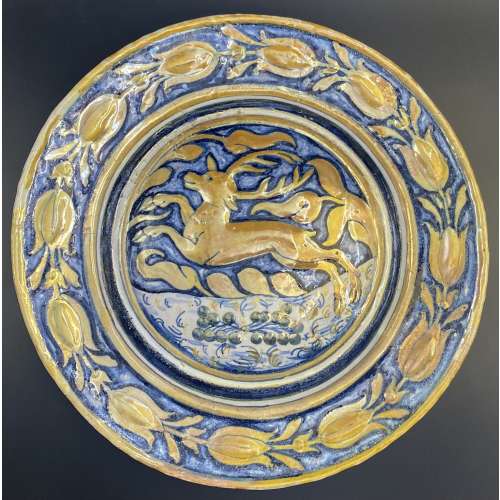 Tin-glazed earthenware plate with lustre in blue and ochre, decorated in relief with a deer in the centre and a chain of tulips on the lip; base signed “CK” in blue. Restored. Diameter: 24.8 cm; Height: 2.5 cm. Attributed to Gubbio (Umbria, Italy), 1520-1550.
Tin-glazed earthenware plate with lustre in blue and ochre, decorated in relief with a deer in the centre and a chain of tulips on the lip; base signed “CK” in blue. Restored. Diameter: 24.8 cm; Height: 2.5 cm. Attributed to Gubbio (Umbria, Italy), 1520-1550. -

Tsuba of oval form decorated with clematis six-petal flowers, tendrils, and leaves in cast brass with details carved in kebori, inlaid on iron plate carved in low relief (kebori and sukidashi-bori). Hitsu-ana plugged with shakudō. Copper sekigane.
Heianjō (or Ōnin) school. Unsigned. Mid Muromachi period (1454-1513). Dimensions: 87.2 x 84.3 x 4.3 mm. Tsuba is illustrated and described in Gary D. Murtha's "Onin-Heianjo-Yoshiro" book on pages 38-39. Mid-Muromachi is the age attribution by Gary. “A picture book of Japanese sword guards. Victoria & Albert Museum“, published in 1927 presents us with a somewhat similar tsuba: "Floral ornament. Iron, with brass incrustation". V&A attributes the tsuba to Ōnin style, 16th century.
-
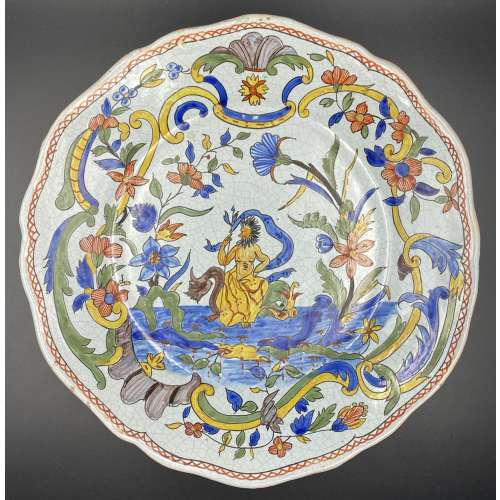 Tin-glazed earthenware polychrome plate with a scalloped rim, decorated with a triton riding a dolphin, surrounded by flowers and arabesque. Diameter: 24.5 cm; Height: 3.5 cm.
Tin-glazed earthenware polychrome plate with a scalloped rim, decorated with a triton riding a dolphin, surrounded by flowers and arabesque. Diameter: 24.5 cm; Height: 3.5 cm. -
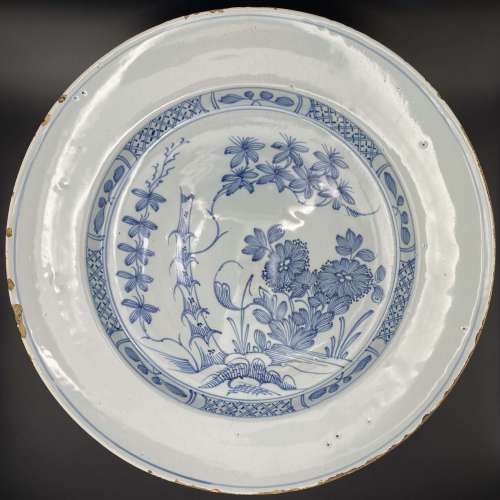 Round plate with a blue and white design of blossoming bamboo and chrysanthemums in the centre with a border of lattice and floral sprays. Diameter: 34 cm, Haight: 5.5 cm.
Round plate with a blue and white design of blossoming bamboo and chrysanthemums in the centre with a border of lattice and floral sprays. Diameter: 34 cm, Haight: 5.5 cm. -
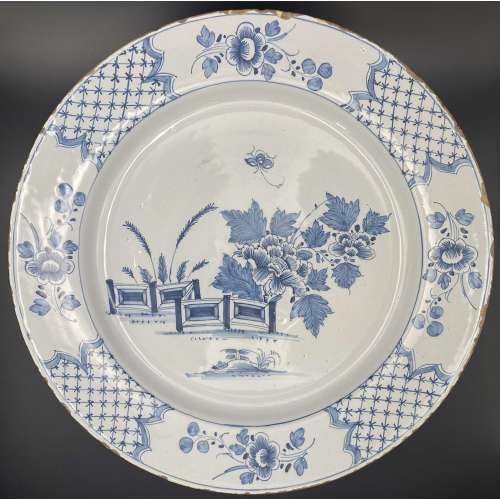 Round plate with a blue and white design of blossoming peony behind a fence with lattice and floral border; flowers to the bottom. Diameter: 33 cm, Haight: 4.5 cm.
Round plate with a blue and white design of blossoming peony behind a fence with lattice and floral border; flowers to the bottom. Diameter: 33 cm, Haight: 4.5 cm.


